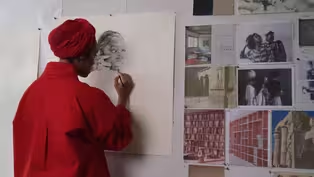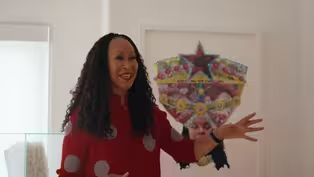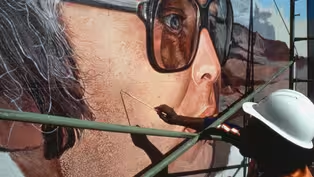
The Legacy of the Paul Robeson Players in 1970s L.A. Black Theater
Clip: Season 15 Episode 4 | 12m 4sVideo has Closed Captions
In 1970s Compton, the Paul Robeson Players emerge as one of L.A.'s longest-running Black theaters.
In the early 1970s, Compton’s Communicative Arts Academy opened as a space for Black artists to explore diverse art forms, leading to the founding of the Paul Robeson Players. Named after the renowned activist and entertainer Paul Robeson, this theater group became a hub for performance, directing, and writing, uniting the Compton community and creating a lasting legacy in Black theater.
Problems playing video? | Closed Captioning Feedback
Problems playing video? | Closed Captioning Feedback
Artbound is a local public television program presented by PBS SoCal

The Legacy of the Paul Robeson Players in 1970s L.A. Black Theater
Clip: Season 15 Episode 4 | 12m 4sVideo has Closed Captions
In the early 1970s, Compton’s Communicative Arts Academy opened as a space for Black artists to explore diverse art forms, leading to the founding of the Paul Robeson Players. Named after the renowned activist and entertainer Paul Robeson, this theater group became a hub for performance, directing, and writing, uniting the Compton community and creating a lasting legacy in Black theater.
Problems playing video? | Closed Captioning Feedback
How to Watch Artbound
Artbound is available to stream on pbs.org and the free PBS App, available on iPhone, Apple TV, Android TV, Android smartphones, Amazon Fire TV, Amazon Fire Tablet, Roku, Samsung Smart TV, and Vizio.
Providing Support for PBS.org
Learn Moreabout PBS online sponsorship-Sit back, everybody, I have a story I want to tell you.
Once upon a time, back in 1971, there was a Communicative Arts Academy that opened their doors for anyone who wanted to be part of the arts, who wanted to learn how to sing, learn how to make sculptures, learn how to paint.
-Now, they also had dance, they had boxing, learning photography, and darkroom technique, learn how to design sets.
-Learn how to act.
I wanted to be a part of that.
Theater is where I started, so let me tell you about it.
-Okay, class, physical exercise.
Ready?
Again.
-The Compton Communicative Arts Academy was part of a community action agency in Compton that provided socioeconomic job training and things like that for people who were underserved.
It also provided a platform for young artists to actually come together and learn a craft in an environment with people close and similar to their own age.
Then we formed the adult workshop at the Communicative Arts Academy, which then later evolved into the Paul Robeson Players.
-The theater was named after Paul Robeson because he was the most well-known and popular individuals that America produced in the '20s, '30s, '40s, and '50s.
[music] -First of all, he's a genius.
Secondly, he was very muscular, tall, athletic.
-He had a magnificent voice.
-Whether he was singing or just saying hello, how are you, with a big, deep voice.
-Part of him was a singer and an actor, an entertainer per se, but he became a very important and valuable political figure because he was for the poor people to be put on a level that he believed that they belonged.
White, black, didn't matter.
He was at the picket lines for whoever.
-In my opinion, he was the first black figurehead that I respected as a modern Renaissance man.
-I was so glad that our group chose him for our model.
[music] -You hear about Compton nowadays, and you don't think of theater when you think of Compton, right?
In those days, that's what people thought of.
-As a young kid growing up in the community, I was very aware of the Paul Robeson players and the things that they were doing.
Our community needs artistic expression, particularly we need the people who live and breathe in this community to have a way by which they can remind us of the kind of great artistic, political, and social legacies that we as African American people have.
-If you remember, this was a time when America was coming off of a series of riots across the country.
Los Angeles, '65.
Detroit, '67.
The atmosphere in the black community was that people were pissed off.
They were tired of how they had been historically treated.
Another part of it, and the part that we were a role player in, if you will, was in the arts.
Black arts exploded across this country during that time with theater, with art, with music.
[music] -I went to a black caucus meeting and I met Robert Carmack and I told him I was new in the city.
He said, ''Well, we have a theater group.''
I went one night and I sat back and was watching everything.
I said, ''Well, this might be interesting to get involved in.
The director, Robert Browning, said, ''Okay, Naomi, I want you to do an improv with Philip.''
I didn't know what improv was.
I want you to love him and help him get through whatever he's going through.
I'm like, what?
I said, ''Okay, I'm going to see if I can do it.''
Well, I did it to my surprise, and he said, ''That was excellent.
I got bit by the bug that night.
That's when I knew, okay, all right, this might be something I would.. to stay in.
-We were able to not only provide opportunities for actors, but we also was able to provide opportunities for young people to actually develop their directing skills.
Robert gave Naomi an opportunity to direct.
-Each person in our group was able to expand their creativity, enhance our crafts, find out about what we can do.
I directed a play called Uncle Rufus, and it's a comedy.
-The play Uncle Rufus came to us from Mildred Dumas.
-Augustus Stone, who was the executive director, he said, ''I don't think I want to deal with this subject matter -It was an interesting play because Uncle Rufus is inviting his relatives so he can tell them that he's going to get married to Flexi.
-When he read it, he thought it was really one of the best plays he had ever read.
-The relatives come, and when they meet Flexi, they realize that Flexi is not a woman.
-Flexi actually was a man who was pretending being a woman.
That was the scandal of the family, of the play.
The way that the play was written, it would not have been acceptable today.
-I became enamored with theater at an early age.
I started writing at 10 years old.
At the age of 14, I wrote my first play.
We had it on my parents' front porch.
We put wooden chairs and benches out in the yard, and my neighbors came in and paid a nickel or a dime at the gate.
I wrote one play called Looking for a Man.
-Mildred contacted me years later and said, ''Hey, Naomi, I need you to direct a play for me.''
I've been doing that ever since.
-I wrote it with a girlfriend of mine.
We were both single.
We sat down one day, and we started thinking about how a group of women would handle that situation.
-Being a part of the Communicative Arts Academy really helped me get over a lot of things, personal things in my life.
It kept me busy.
It took away some of the pain of my past dealing with my marriage.
-The audience really received it well, because the situations we talked about were actual situations that happened in relationships.
-He looks immaculate.
He looked captivating.
He was the most perfect male specimen alive.
His eyes were on [?]
-I am 91 years old.
I'm still looking for a man.
-They loved us.
We did two shows in one night at two different places.
-We so excited.
We didn't have a lot of money at the Arts Academy, but because they were a nonprofit organization, a lot of people donated old sets, props that they didn't need.
-It forced us to dig deep into our creative reservoir to come up with a way of getting the job done.
-You would see a lot of old military parachutes, and they put that up to help soak up some of the sound inside of this big, what used to be a warehouse that held car parts.
-We may not have had money, but we didn't operate on the cheap, and there's a difference.
-Having young people exposed to the arts can be a window to open up different worlds, different cultures, different understanding.
-Theater provides you with a vehicle to do all of those things.
-They came to the company and learned how to articulate and learned how to use their vocal cords and their breathing to speak before public.
-I still have, to this day, a bad, big, right toe, and the reason is I dropped a flat on my toe during a Paul Robeson Player production 50-some years ago, and the damn thing still hurts when it gets cold.
-Our group was all about teaching.
We were able to learn different aspects of the arts, and it was free to the community.
To see all ages walk in and out of that place learning something really inspired me.
-I went to Cal State Dominguez, but the bulk of what I learned came from a little bitty ragtag group called the Paul Robeson Players in the City of Compton.
-We partied like crazy together.
We worked hard.
We fought.
We argued.
We did all of the things that a family, a communal family would do Then when it was time to go up on stage, and when the lights came on, it was pfft.
-It was amazing, and I would do it all over again.
-The lasting legacy of the Paul Robeson Players, in my opinion, is that as we evolved, we started to bring all people into it It was a black theater company, but we started doing other cultures where everybody is inclusive.
-You don't get to put that together unless you have a really special group of people trying to do something positive for the community, and that's what the Paul Robeson Players did.
-To help people to enjoy life, that's what it helped me, is to enjoy life and to make people laugh or make them cry, make them fall in love.
That's my job.
On the stage and off.
-One of you killed Rufus, and I'm going to find out who.
Cutting him down in his prime, just when he was about to begin a new life with that cute little fiance of his.
-What?
-Sure wish I could pick up where he left off.
Woo.
Yes, indeed.
Blackout.
-Redirecting your traffic.
[laughter] -I'm staying out of your lane.
I'm sorry.
-Notice I kept my mouth shut.
-That's why I went to school.
No, I'm just kidding.
-Too late.
-Too late.
Black Art: A Brockman Gallery Legacy (Preview)
Preview: S15 Ep4 | 30s | Brockman Gallery was the center of a community of Black artists in L.A. from 1967-1990. (30s)
Dr. Joy Simmons' Collection Represents Decades of African American Art
Clip: S15 Ep4 | 1m 57s | One of the most important African American art collections lives in a Los Angeles home. (1m 57s)
'84 Olympic Freeway Mural Project Pulled Talent From Diverse L.A. Communities
Video has Closed Captions
Clip: S15 Ep4 | 3m 56s | Ten murals in total were commissioned by artists of various ethnic backgrounds and styles. (3m 56s)
Providing Support for PBS.org
Learn Moreabout PBS online sponsorshipSupport for PBS provided by:
Artbound is a local public television program presented by PBS SoCal














